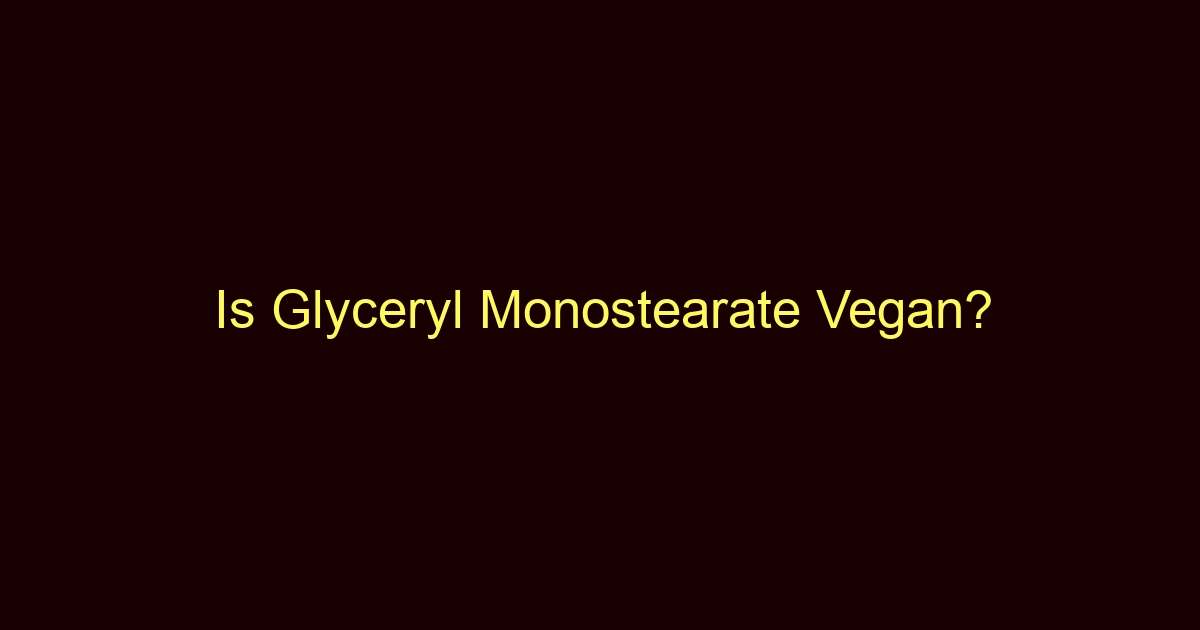If you’re a dedicated label reader or a food enthusiast, you’ve probably come across glyceryl monostearate in the list of ingredients more than once. It’s found in many foods and personal care products, but is it suitable for vegans? Let’s delve into the details and find out!
What is Glyceryl Monostearate?
Glyceryl Monostearate, or GMS for short, is a type of fatty acid used widely in the food and cosmetic industries. It’s typically white in appearance, waxy, and odorless, with a slightly sweet taste. It plays a dual role as an emulsifier and a preservative in various products, making it a versatile and valuable addition to many formulations.
The key characteristic of glyceryl monostearate is its ability to bind ingredients together that would typically separate – think oil and water. This quality is critical in maintaining the consistency and stability of many products we use daily. However, its importance begs the question: what exactly is glyceryl monostearate made from?
What is Glyceryl Monostearate Made Of?
Glyceryl Monostearate is derived from glycerol and stearic acid. Glycerol is a simple polyol compound, whereas stearic acid is a long-chain fatty acid. The combination of these two compounds results in a molecule that has both hydrophilic (water-attracting) and hydrophobic (water-repelling) parts, making it an effective emulsifier.
The critical consideration here is that both glycerol and stearic acid can be sourced from either animal or plant origins. Stearic acid can be found in animal fats, but it’s also present in plant fats like coconut and palm oil. Similarly, glycerol can also be sourced from either animal fats or vegetable oils. Hence, the vegan status of glyceryl monostearate is dependent on its sources.
What is Glyceryl Monostearate Used For?
Glyceryl Monostearate is used in various industries due to its properties as an emulsifier, thickening agent, and preservative. In the food industry, it’s found in items like ice cream, whipped cream, candy, and baked goods, where it helps create a smooth texture and prevents ingredients from separating.
In cosmetics, glyceryl monostearate is used in creams, lotions, and other products to help combine water and oils into a consistent, spreadable product. It also adds a moisturizing effect to these products.
What Products Contain Glyceryl Monostearate?
Glyceryl Monostearate is found in a wide range of products. In food, it’s present in baked goods, dairy products, processed meats, and margarine, among others. In cosmetics, it’s used in products like creams, lotions, makeup, and even in some hair care products.
Is Glyceryl Monostearate Vegan?
The answer to whether glyceryl monostearate is vegan can vary. It ultimately depends on the source of its components: glycerol and stearic acid. If these components are derived from plant sources, then yes, glyceryl monostearate is vegan.
However, if they come from animal sources, it’s not vegan. The problem is that it’s often challenging to know the origin of these ingredients from the product labels. When in doubt, it’s best to reach out to the product manufacturer for clarification.
Can Vegans Use Products Containing Glyceryl Monostearate and Why?
As a general rule, vegans can use products containing glyceryl monostearate, provided it comes from plant sources. But the uncertainty lies in the source of the ingredient, which often isn’t specified on the product label.
If you’re a vegan who strictly avoids any product that might contain animal-derived ingredients, it might be best to seek alternatives or reach out to the manufacturers to confirm the source of glyceryl monostearate.
Safety and Environmental Concerns of Glyceryl Monostearate
Glyceryl monostearate is generally recognized as safe (GRAS) by the Food and Drug Administration (FDA) in the US. It’s widely used in foods and personal care products with no significant health concerns. However, as with any substance, individual reactions may vary, and some people may experience minor skin irritation from cosmetic products containing GMS.
In terms of environmental concerns, it’s worth noting that palm oil is a common plant source of stearic acid, a component of glyceryl monostearate. Palm oil production has been linked to deforestation and habitat destruction, particularly in Southeast Asia. If sustainability is a concern for you, look for products from companies committed to sustainable sourcing practices.
Alternatives to Glyceryl Monostearate
If you’re a strict vegan or have concerns about the environmental impact of palm oil production, you might want to consider products that use alternatives to glyceryl monostearate. For food products, lecithin (particularly soy lecithin) is a commonly used emulsifier that’s plant-derived.
For cosmetic products, there are many plant-based emulsifiers available. These include lecithin, cetearyl alcohol (derived from coconut or palm oil), and different types of polysorbates.
Is Glyceryl Monostearate Safe?
Glyceryl monostearate is safe for use in food and cosmetics. It’s a commonly used ingredient approved by food safety authorities, including the FDA. Some people might have individual sensitivities or allergies, as with any ingredient, but these are relatively rare.
Final Thoughts
Glyceryl monostearate can be vegan, but it depends on the source of its components. As consumers, it can be difficult to discern the origin of this ingredient from product labels.
If you’re a strict vegan or have concerns about the environmental impact of palm oil production, consider contacting the manufacturer or choosing products that use plant-based alternatives. As always, making informed choices that align with your dietary needs and ethical considerations is important.

